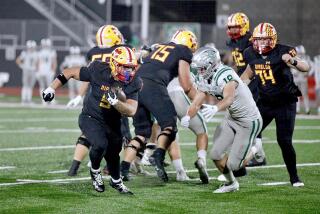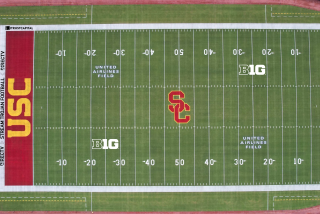Freedom of Speech at Stanford: Saying No
- Share via
Trust, in the bowl business, holds the same present standing as the Cherry, Camellia, All-American and Garden State bowls, which is to say, let them rest in peace.
Trust, in the bowl business, is how you can go from thinking Stanford’s in your game on Tuesday to waking up in a Tulsa hotel room on Saturday.
The Freedom Bowl screwed up. The Freedom Bowl trusted Stanford. It trusted Stanford when Stanford’s athletic director, Ted Leland, assured the Freedom Bowl Tuesday morning that the Cardinal was coming. It trusted Stanford when the commissioner of Stanford’s athletic conference, Tom Hansen, assured the Freedom Bowl Tuesday morning that the Cardinal was coming.
It trusted Stanford until Tuesday afternoon, when Leland phoned back to say Aloha.
Aloha to Anaheim.
Hello to the Aloha Bowl.
“We had them for four hours, anyway,” says Don Andersen, the Freedom Bowl’s executive director. “For four hours, we acted as if the deal was done. . . .
“Stanford was the kind of team we had targeted all along--a California Pac-10 team to be our anchor team. Twenty-nine percent of all Stanford graduates live in Southern California. So many of their students could have made it down for the game. A lot of big-money alums in Orange County had always wanted to see Stanford in a bowl game.
“It was in our grasp, seriously.”
We interrupt this pleasant thought sequence for an announcement by ABC television.
ABC, owner of the broadcast rights to the 1991 Aloha Bowl, noticed Tuesday morning that it had a game, one of only two football games scheduled to be televised on Christmas Day, and no one to play in it. In a pinch, ring up an old friend. Dennis Swanson, president of ABC Sports, knew Stanford Coach Dennis Green from their Chicago days--Green coached at Northwestern, Swanson worked at the local ABC affiliate--so he phoned to ask what’s up, knowing fully well that Green’s Stanford team was.
Stanford had just beaten UCLA. Stanford was hot. ABC could offer Stanford something the Freedom Bowl’s TV packager, Raycom Sports, could not--major network exposure and, just maybe, no guarantees or anything like that, two or three regional broadcast slots next season.
When Andersen got the bad news, it was delivered by Leland. “It wasn’t going to be Hansen,” Andersen said of his longtime friend in the Pac-10 commissioner’s chair. “I’ve known him all his life.” Leland drew the straw, and when he called, Andersen says, his message was, “We’re going to the Aloha Bowl--I’ve never been so embarrassed in my life.”
Andersen had a different description for his emotions.
“Total shock,” he said. “Total disappointment. We were already talking about how Stanford was going to help the image of our game, to say nothing of the gate.
“We feel like we’d been progressing the last 1 1/2 years, that we were getting on a pretty good roll to make up for the financial losses we’d taken earlier. We were kind of looking at this game as helping us take the next step forward.”
Now, will that step be back, back, back, over and out? Stanford-Anybody would have qualified as the Freedom Bowl’s most attractive marquee since UCLA-BYU in 1986. Stanford-BYU seemed a possibility Tuesday morning, assuming a BYU loss in the WAC championship eliminator with San Diego State, and wouldn’t that have been a pretty picture? “The stands would have been red, white and blue,” mused Freedom Bowl publicist Paul Mortenson.
Instead, the lobby of the Tulsa Westin is decked out in red, white and blue, decorated with Freedom Bowl logos and “Take Tulsa” signs. Andersen still has a verbal agreement to take the WAC runner-up--that is, unless MTV steps in--but in the opponent’s slot, he says he is still considering Georgia, North Carolina, Kansas, Fresno State, Pittsburgh . . . and Tulsa.
Andersen was in Tulsa this weekend for a scouting mission, and though the Oklahoma oil fields are a long way from South Coast Plaza and Palo Alto, Andersen had to admit: It feels nice to be loved.
“I was driving into town, and three of the biggest buildings had their windows lit up to read ‘UT,’ ” Andersen said. “You don’t see that in downtown Anaheim. You don’t see that in downtown Palo Alto, either.
“When I got to the hotel, they had all these bouquets of red, white and blue flowers in the lobby, with the Freedom Bowl logo in the back. We’ve received over 200 faxes already from Tulsa.
“In that way, Tulsa does fit the profile of the kind of team we want--a university on the way up that would be excited to play in the Freedom Bowl.”
The Freedom Bowl doubled that strategy last year by bringing in December neophytes Oregon and Colorado State, and got a great game out of it. Pretty fair crowd, too.
But Tulsa?
In case of emergency, Andersen is seeing if he can talk himself into it. “Tulsa is the only team to beat Texas A&M; this year, and Texas A&M; will probably be 10-1 going into the Cotton Bowl,” he said. “Tulsa has players today who are breaking the school records of people like Jerry Rhome, Steve Largent, Howard Twilley and Drew Pearson. In the 1960s, Rhome-to-Twilley was comparable to John Huarte-to-Jack Snow at Notre Dame. The year John Huarte won the Heisman, Jerry Rhome finished second.
“So it’s a school with a real good football tradition.”
Rest assured, Andersen wouldn’t be researching it if the bright minds at Stanford hadn’t redefined the meaning of the phrase, “Yes, we’re coming.” Even in light of the facts, and faxes, about Tulsa, Andersen says he’s planning to wait a week and see if his game might be able catch a late break. Even a good one.
“We were with Stanford when Stanford was 1-3,” said Andersen, mulling what might have been. “We had a representative at the Cornell game (in early October). We were the only bowl in the building.
“That was one reason why Leland said he wanted to play in our game, because of our loyalty. They were so big on our loyalty.”
So big on the Freedom Bowl’s, so small on their own.
More to Read
Go beyond the scoreboard
Get the latest on L.A.'s teams in the daily Sports Report newsletter.
You may occasionally receive promotional content from the Los Angeles Times.










